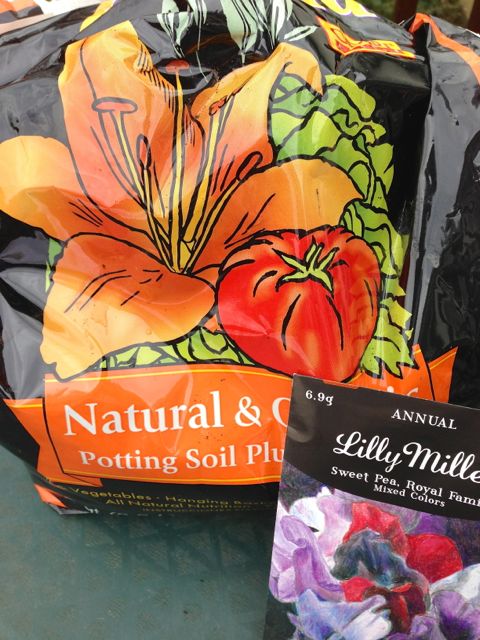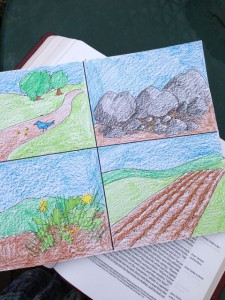 “Now the parable is this: The seed is the word of God.” (Luke 8:11)
“Now the parable is this: The seed is the word of God.” (Luke 8:11)
Help your children learn more about God’s Word and our response to it with this springtime activity!
You’ll need: your Bible, some paper and drawing materials, a packet of bean or sweet pea seeds, a small bag of potting soil, and some small flower pots or recycled milk or yogurt cartons (if you choose to complete Step 2 of this activity indoors)
Step 1:
Read Luke 8:4-15 aloud with your children. If they are old enough to read, take turns reading the verses together.
Give each child a piece of paper and fold it in half both directions to create four sections. Have the children illustrate each of the places the seed was planted, with one drawing in each section of their papers.
 In the path
In the path- On the rocks
- Among the thorns
- In good soil
Talk about the meaning of Jesus’ parable. What kind of response to God’s Word is represented by the seeds in the path? Who is pictured by the seeds planted in the rocks? What about the seeds in the thorns? And last, who is represented by the seeds planted in the good soil? Talk about what kind of “soil” they are when they hear God’s Word.
Step 2: (You may want to do this activity on a different day.)
If you have space outside: Work with your children to plant your seeds in four different places as they are described in the parable of the sower.
- Set some seeds on a path, sidewalk, or driveway and sprinkle them with water. Use a piece of chalk and draw a circle around your seeds or mark the area in some other way so you can come back later to look for them.
- “Plant” some seeds in a rocky or gravelly area. Try to put a bit of dirt over them. Water the area. Mark this area with a stick or other marker for future reference.
- Plant and water some more seeds in the middle of a weedy area and mark them.
- Plant the last seeds in a prepared area and water them. This might be directly in your garden (into well-worked soil) or in a flower pot to place on your porch or deck. Use good quality potting soil if you plant your seeds in a pot. Be sure to follow directions for how deep the seeds should be planted.
If you are working inside: Gather four small flower pots or empty milk or yogurt containers. If you use recycled containers, be sure to poke a few drainage holes in the bottom of each.
- Put some seeds in an empty pot or container or on a plate or plastic lid. Sprinkle them with water.
- Fill one container with gravel and put some seeds down into the gravel. Water.
- Scoop up some weedy soil from outside to put in a container indoors. Plant some seeds in this soil and water them.
- Fill the last container with purchased potting soil. Be sure to follow directions for how deep the seeds should be planted. and water them thoroughly. Place them in a window, and keep them damp (but not overwatered) until they sprout. (These can be transplanted to an area outside after they have grown a bit.)
Check on the seeds every couple of days. Are the ones on the “pathway” still there? Do you see any growth yet? Have some sprouted and died? Appoint one child to be your record keeper and note the date and your observations each time you look at the seeds.
Continue to review the lesson from this parable as your watch your seeds grow (or die). Go back and read the parable again. Read a retelling of this parable in a children’s storybook. The Sower and the Seeds, by Mary Berendes, is a nicely illustrated Kindle version you can read right away (for $2.99!) Other options are The Parable of the Sower, by Helen Rayburn Caswell, The Seeds that Grew and Grew (Arch book), and Sowing and Growing, by Marilyn Lashbrook.
Transplant any seedlings that survive into a pot or area where you can enjoy their growth throughout the summer. They’ll be a good reminder of this parable and our response to God’s Word every time you see them!
